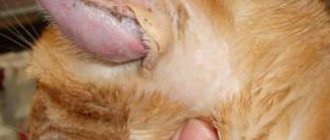The kidneys are an important organ for both the human and feline body. With their help, substances harmful to the body are removed. The kidneys play a significant role in the body's metabolic processes. Pathology in the kidneys is a serious metabolic disorder
and contributes to the development of various diseases.
Kidney failure is a disease that affects the functioning of all body systems. But clinical manifestations are visible only when 65-80% of the kidney tissue is already affected. The earlier the disease is detected, the longer the cat will live after proper therapy.
In renal failure, the kidneys perform their main function—excretory—poorly or stop performing altogether. Problems in the excretory system upset the balances:
- Acid-base;
- Water-salt;
- Osmotic.
These disturbances trigger problematic conditions in other internal organs.
Kidney failure occurs more often in cats of the Persian and British breeds, since they are more susceptible to a congenital anomaly - polycystic kidney disease. And this disease provokes chronic renal failure.
Abessinian cats suffer from amyloidosis, which also causes chronic renal failure.
There is no clear opinion about who is more predisposed to the disease – males or female cats.
Treatment of renal failure can be effective only in the initial stage. The prognosis for recovery is significantly reduced if the disease is advanced. If any minor signs of illness appear, you should immediately contact a veterinarian.
The symptoms of kidney failure are similar to those of other diseases, so the cat must be fully examined to establish an accurate diagnosis. You should not give your animal any medications on your own. Only a specialist can treat a pet.
Main causes of kidney disease in cats
Kidney disease is a common problem in cats, affecting more than 1/3 of older cats. There are a number of reasons that may affect different age groups and have different consequences. Ultimately, unfortunately, chronic kidney disease (occurs over time) or acute kidney injury (occurs suddenly) will always have the same result—the cat will be sick. Signs of illness in your cat reflect the inability of the kidneys to perform their many functions well enough.
Below you will find a brief description of the ten most common causes of kidney disease. These are the goals of your veterinarian's diagnosis.
The most common pathologies
In most cases, the cause of kidney pathologies is difficult to determine. The most common causes are infections, systemic diseases, injuries, poisoning, and unbalanced nutrition. All cats over 7 years of age are at risk.
The most common kidney diseases are nephritis - pyelonephritis, glomeronephritis, hydronephritis. These are inflammatory processes of different localization and different bacterial nature.
Concretions (stones) can form in the renal ducts and block the ducts, which leads to urolithiasis and enlarged kidneys in the cat. This disease is most typical for older castrated cats that have been fed dry food and fish for life. Shifts of stones are painful and occur in attacks; there are often traces of blood in the urine.
The most severe pathology is the syndrome of impairment of all renal functions. It often leads to chronic renal failure (CRF), which has a poor prognosis. With this pathology, the nephrons are replaced by connective tissue, and the cat’s kidneys are enlarged. It can be cured, although it is very difficult. More often it is only possible to stabilize the animal, provide supportive therapy and prolong life.
Infection of the kidney tissue (pyelonephritis)
Infection of kidney tissue by bacteria or, less commonly, fungal organisms is one of the kidney diseases that may have a more favorable outcome, so your veterinarian will be on the lookout. Our goal when treating pyelonephritis is to kill the bacteria that cause destructive inflammation. This should limit the progression of any chronic kidney disease or aid in recovery from acute kidney injury. Urine bacterial culture and susceptibility can determine the type of infection and determine which antibiotic may work best.
Comprehensive treatment
Therapy will depend on the causes that led to the pathology.
For congenital pathologies, symptomatic therapy is used, for tumors - surgical intervention.
Pathologies of inflammatory etiology caused by bacteria will require treatment with antibiotics.
To eliminate dehydration, drip infusion of saline is used. Maintenance therapy is also necessary to relieve associated symptoms - anemia, blood pressure, disorders of the liver and gastrointestinal tract.
But the main thing is a special diet and drinking regimen, which is adjusted by the veterinarian. It is the diet that will reduce the load on the remaining working nephrons and preserve them.
Renal obstruction (ureteral obstruction with hydronephrosis)
Kidney stones can fragment and travel through urine into the ureter, the long, narrow tube that connects each kidney to the bladder. They are likely to cause severe pain as they move, and significant difficulty in functioning results in the kidney if they become lodged in the ureter, causing partial or complete blockage. New urine cannot pass out of the kidney easily and it recedes, causing the kidneys to swell. If there is enough pressure, the kidneys become enlarged (hydronephrosis) and damaged. If both ureters become blocked at the same time, this can lead to catastrophic consequences, including death.
general information
In cats, like all mammals, a pair of kidneys is located in the abdominal cavity in the area of the lumbar spine. These bean-shaped organs have a complex structure, the structural unit of which is the nephron. It is in these glomeruli, entangled with blood vessels, that the main function of the kidneys is carried out - filtering metabolic products.
Main, but not the only one. In addition, the kidneys play an important role in the hormonal regulation of the body, regulate the acid and electrolyte composition of the blood plasma, and participate in maintaining blood pressure. The cups of the kidneys collect urine, which travels through the paired ureters into the bladder. And it is already removed from the body.
Slags
Many household items can damage your kidneys, not just antifreeze. Petals, leaves and pollen from lilies, even water in their vase, can cause serious kidney injury when cats nibble, lick or chew the flowers or come into contact with water. This is one type of flower that you should avoid completely if you have a cat! Common OTC medications such as aspirin, other nonsteroidal drugs (NSAIDs), or prescription drugs can all cause kidney disease. Cats, who are known for being picky about food and just about everything else, will still eat pills they find in your medicine cabinet or on the floor, so keep all medications in cat-proof containers. And always discuss the use of any medications with your veterinarian.
If you have any reason to believe that your cat has been poisoned, call your veterinary emergency number immediately for help. Contact us at the following numbers:
8-495-221-81-90
8-495-221-84-70
8-499-136-19-18
Prevention is easier than cure
Regardless of how old your cat is, the following recommendations will help maintain his health and prolong the full life of your pet:
- Maintain proper diet and drinking habits. Freely available clean water, healthy and balanced food, and vitamins will prolong the joy of your communication. Feed your pet proven food and avoid a mono-diet.
- Ensure that medications are limited. Remember, too much is not good. If your cat is prescribed medication, follow the prescribed dosages.
- Monitor your cat's weight. Obesity is dangerous due to various pathologies not only for people, but also for cats.
- Monitor the thermal regime - overheating is just as harmful as hypothermia of the animal.
- Visit your veterinarian regularly and keep up with your vaccination schedule.
Damage to kidney filters (glomerular disease)
The glomerulus (the kidney's filtration mechanism) may be involved in feline kidney disease. Early on, we don't expect any signs of illness from this condition, but since glomerular disease can be caused by infections such as FIP/FeLV or cancer (among other things), time can make problems worse. Over time, inflammation in the glomerulus of the kidney damages the surrounding kidney tissue, creating chronic kidney disease, which makes your cat feel sick.
Diet for a cat
How to feed a cat with an enlarged kidney? An individual diet, as already mentioned, is prescribed by the attending veterinarian, but the general recommendations for feeding the animal are almost always the same.
© shutterstock
Firstly, you should pay attention to the water that the animal drinks. Under no circumstances should you give your cat unfiltered tap water. Water should be either filtered or bottled. In addition, you should ensure that the animal always has access to drink - this will help avoid dehydration.
Secondly, it is imperative to review your pet’s diet. If the kidneys are enlarged, cheap, low-quality food should be excluded from the diet. The amount of protein foods and foods high in phosphorus is also often reduced.
FIP or FIP (feline infectious peritonitis)
The kidneys are the main target for this severe inflammatory disease of domestic and feral cats. Some cats, especially young ones, develop a fever and effusions (fluid accumulation) in the chest or abdomen, but these quickly subside. Cats with non-effusive (dry) FIP tend to be older and show more subtle signs of the disease. Your veterinarian may become concerned about the possibility of FIP if the kidneys feel swollen and lumpy, lumpy (inflammatory cells can distort the outer layers of the kidney).
Diagnostics
Competent treatment of kidney hydronephrosis in an adult or child is impossible without a high-quality comprehensive examination. Only it allows you to determine the type of disease, the degree of organ damage and other features of the pathology.
Diagnostics include:
- clinical and biochemical blood tests
- Analysis of urine
- Kidney ultrasound
- X-ray examination of the kidneys
- CT and MRI
- cystourethrography
- radioisotope study (nephroscintigraphy)
Cancer
Fortunately, kidney cancer is not very common in cats. Unfortunately, treatment options for kidney cancer are quite limited. Solitary tumors affecting only one kidney can be removed surgically with a very good outcome if the tumor is benign or if the cancer has not spread to other parts of the body (including the opposite kidney). Your cat only needs one good kidney to function properly. If the cancer has already spread throughout the body (as usually happens with lymphosarcoma), surgery will no longer be an option for treatment. Microscopic analysis of a biopsy, that is, material obtained with a small special needle, is necessary for the correct diagnosis of cancer and for an appropriate treatment plan.
Bacteria in urine. Why don't they need to be treated?
Urologists often have to tell patients that the presence of bacteria in the urine is not a reason to prescribe treatment - unless other changes are detected in the tests and there are no other complaints. We explain why in the case of asymptomatic bacteriuria there is no need to look for its cause, “go to the doctor” and ruthlessly “remove bacteria” with antibiotics.
Asymptomatic bacteriuria is the release of a certain number of bacteria in a portion of properly collected urine from a patient without signs and symptoms of urinary tract inflammation.
The diagnosis of asymptomatic bacteriuria is established by the results of urine culture - when a bacterial concentration of ≥105 is detected in two consecutive analyzes in women and in one analysis in men.
The prevalence of asymptomatic bacteriuria in women increases with age, from 1% in schoolgirls to >20% in women over 80 years of age.
There is a relationship between the presence of bacteria in urine and sexual activity: for example, studies have shown that sexually active women have a higher prevalence of asymptomatic bacteriuria than nuns of the same age.
However, in young healthy women, asymptomatic bacteriuria rarely lasts longer than a few weeks.
Normally, urine is sterile, but under certain conditions it can be a good breeding ground for bacteria, for example, in diabetes.
The presence of bacteria in a general urine test does not indicate that any bacteria must be cultured during bacteriological analysis (during urine culture). Likewise, an elevated white blood cell count does not always indicate the presence of bacteria in the urine.
In men, asymptomatic bacteriuria is rare. Detection of bacteria in urine is possible in 6-15% of elderly men over 75 years of age. In the presence of asymptomatic bacteriuria in young men, further examination is recommended to exclude bacterial prostatitis.
There is no need to treat asymptomatic bacteriuria.
Treatment for asymptomatic bacteriuria is not required because:
- the presence of bacteria in the urine does not increase the likelihood of developing bladder and kidney diseases;
- does not lead to increased mortality;
- antibiotics initially sterilize the urine in almost all patients, but bacteriuria reappears after about 6 months. That is, treatment with antibiotics is not only useless, but also harmful, since bacteria develop immunity to antibiotics (resistance).
Treatment of asymptomatic bacteriuria is indicated in a small group of patients:
- patients who are planning to undergo surgical treatment with possible damage to the mucous membranes of the urinary tract and possible bleeding;
- patients who have undergone a kidney transplant;
- pregnant women.
With pregnant women, not everything is clear. According to statistics, 2-10% of pregnant women are diagnosed with asymptomatic bacteriuria. Often, if there are bacteria in a general urine test or the presence of bacteria in a low titer (for example, 10³), a woman is immediately prescribed an antibiotic, which, most likely, is not needed at all.
The fact is that most studies on the diagnosis and treatment of asymptomatic bacteriuria in pregnant women date back to the 70-80s of the last century. According to their results, 20-30% of pregnant women with BD develop acute pyelonephritis, which is associated with miscarriage, low fetal weight and other unfavorable factors. But over the past decades, many factors have changed, and modern studies (though not numerous) show a low risk of developing pyelonephritis in pregnant women with asymptomatic bacteriuria - about 3%!
The official guidelines of the European Association of Urology and Russian recommendations indicate that it is necessary to treat asymptomatic bacteriuria in pregnant women. Perhaps with more quality research on this topic, the recommendations will change. In the meantime, short courses of antibiotic therapy are indicated to reduce the incidence of side effects. It is possible to use fosfomycin (Monural) or a penicillin or cephalosporin antibiotic (Amoxiclav, Suprax).
Author:
Loktev Artem Valerievich andrologist
,
urologist
Protein metabolism disorder (amyloidosis)
Patients with amyloidosis lose function of certain organs, including the kidneys, as protein deposits replace normal tissue. It is an unusual consequence of chronic inflammation affecting other parts of the body, or it may be genetic in some breeds such as the Abyssinian, Siamese or Oriental Shorthair. Amyloid deposits cannot be removed, and functional kidney tissue that is lost cannot be replaced, so the prognosis is not good.
Insidious organ
Any disturbance in ensuring normal metabolism and removal of excess substances from the body leads to systemic pathologies. And here it is important to know that kidneys, like no other organ, are disposable items. The number of nephrons in a kitten’s kidney is determined from birth, and they can only die, but cannot regenerate.
Another feature of the structure of the kidneys is that they do not contain pain nerve endings. That is why, when they begin to make themselves felt, this indicates an already mature pathology.
Here 10% of nephrons died - the cat is healthy, 20% - unchanged. And 50% of the nephrons died, and the animal got sick. And if more than 70% of the nephrons of the kidneys die, the prognosis of the disease is very disappointing.










